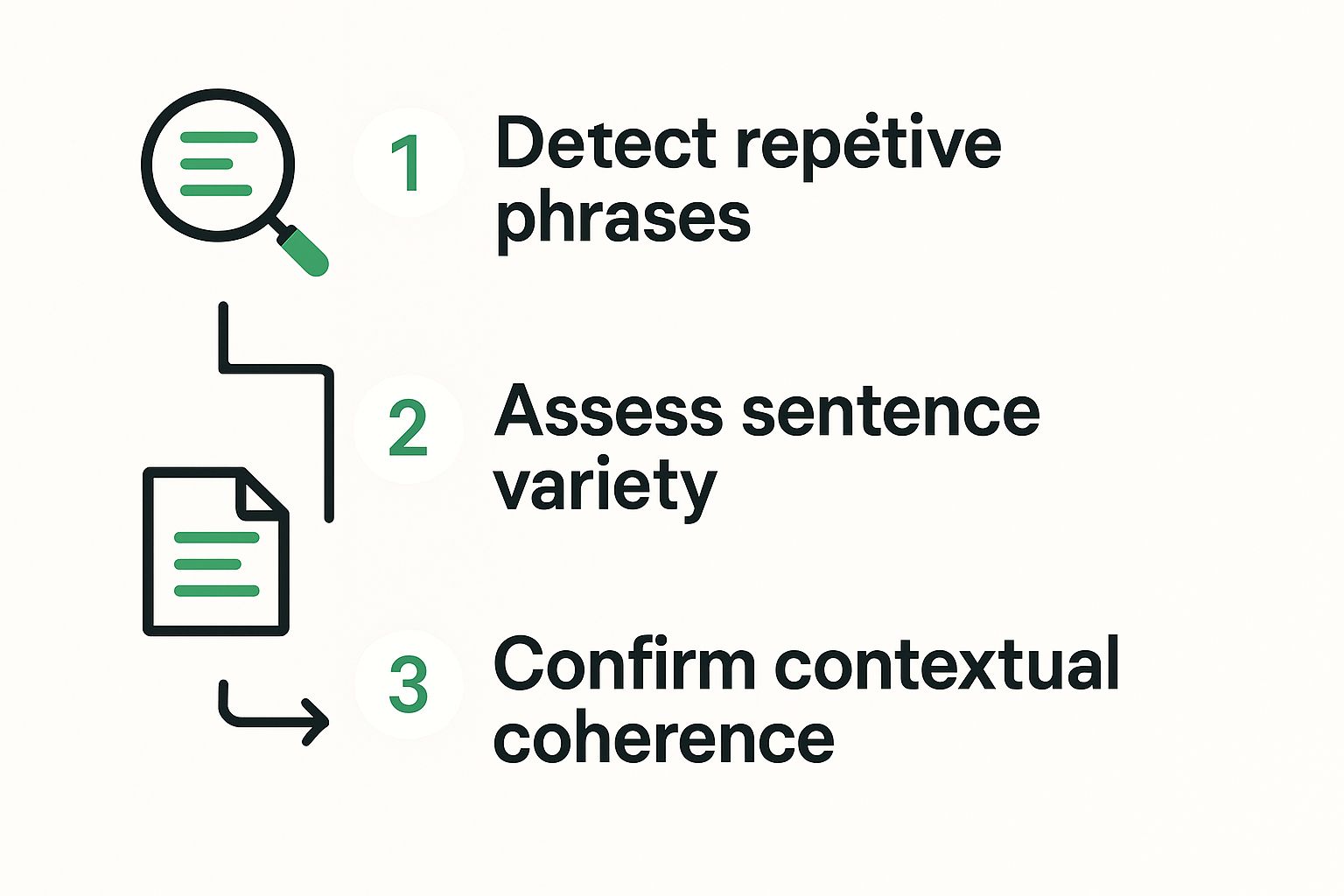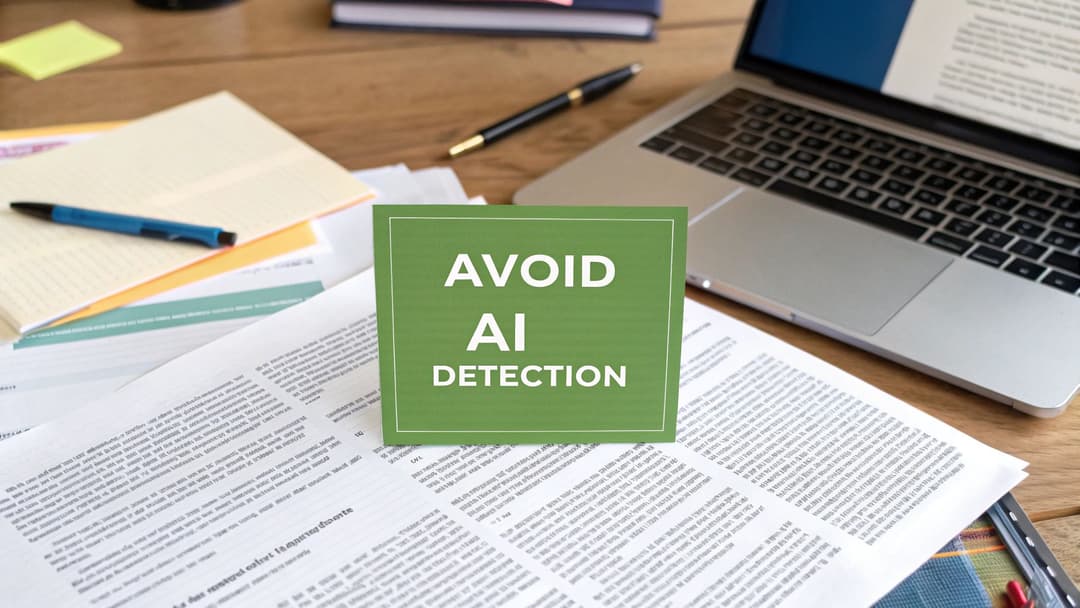
How to Pass AI Detection and Humanize Your Content
July 13, 2025
If you want to get past AI detection, you first have to know what you’re up against. Think of it like this: AI detectors are basically pattern-recognition machines. They're trained to spot the tell-tale signs of AI-generated content—things like robotic sentence structures and overly predictable word choices.
Once you learn to recognize these patterns yourself, you can start breaking them on purpose.
Understanding How AI Detectors Actually Work

Before you can sneak past the guard, you need to know how they think. These detection tools aren't magic; they're just algorithms trained to spot the digital fingerprints left behind by other algorithms. They perform a deep stylistic analysis, hunting for traits that just scream "machine-written."
Most detectors zero in on two key metrics to make their call: perplexity and burstiness. These are the main clues they use to figure out if a human or a bot is behind the keyboard.
The Role of Perplexity and Burstiness
Perplexity is just a fancy way of saying "predictability." AI-generated text often plays it safe, using common words and phrases over and over. This makes the text highly predictable, giving it a low perplexity score.
Human writing is different. We’re all over the place. We use a richer vocabulary and build sentences in weird and wonderful ways, which makes our writing far less predictable.
Burstiness, on the other hand, is all about rhythm and flow. It measures the variation in your sentence length. Humans naturally mix it up—we'll write a long, flowing sentence followed by a short, punchy one. AI models? Not so much. They tend to create sentences of a similar length, which results in a flat, monotonous rhythm that detectors can spot a mile away.
The bottom line: AI detectors thrive on uniformity. The more you can vary your sentence length, word choice, and structure, the more human your text will feel—and the better your odds of flying under the radar.
The AI Security Paradox
There’s another layer to this challenge, something known as the 'AI Security Paradox.' The use of generative AI is absolutely exploding—it's projected to jump by a massive 187% between 2023 and 2025. But investment in AI security is only growing by 43%.
This gap means the tools for creating AI content are getting better much, much faster than the tools designed to police it. You can learn more about how this is shaking up digital security over at metomic.io.
This paradox creates a strange situation where AI's greatest strength—its efficiency and consistency—also becomes its biggest weakness. The very systems built to be helpful leave behind an obvious, machine-like trail.
So, to reliably beat AI detection, you have to get your hands dirty. It’s not about just swapping a few words here and there. It’s about deliberately injecting a bit of human chaos into the sterile, orderly world of AI text. You have to learn to write in a way that avoids the exact signatures these tools are designed to find.
Knowing the rules of the game is the first step to winning it.
Alright, let's transform that robotic section into something that sounds like it was written by a real, experienced content pro.
Here is the rewritten section, designed to match the provided examples' style and voice, while keeping all the critical elements intact.
Core Strategies to Humanize AI-Generated Text
This is where the real work begins—turning that robotic draft into something that actually sounds human. It’s not about a quick find-and-replace; it’s about changing the text’s DNA. To get past AI detection, you have to give the content a personality, a clear point of view, and the kind of natural rhythm that machine writing just can’t replicate.
Think about it: AI often spits out content that's technically correct but completely sterile and uniform. Our job is to inject the subtle imperfections and variations that make writing feel authentic. This means rolling up our sleeves for a thoughtful editing pass focused on voice, flow, and personality.
Develop a Unique Voice and Point of View
The biggest giveaway of AI content is its lack of a real voice. It’s written to be so neutral and generic that it ends up connecting with no one. The first thing you need to do is give your text some personality.
Are you the skeptical expert? The enthusiastic guide? The witty commentator? Pick a persona and let it guide your word choice and tone. A personal story, a strong opinion, or even a little bit of humor can instantly make the content feel more genuine.
For example, an AI might say, "It is important to consider multiple factors." Yawn. Try something with a real voice: "Look, if you're not weighing these factors, you're pretty much setting yourself up for failure." That small shift in tone changes everything.
Key Takeaway: A strong, consistent voice is your best defense against AI detection. An algorithm can copy information, but it can't fake your unique perspective. That’s your superpower.
This infographic breaks down a simple, effective workflow for spotting and fixing the most common AI writing tells.

Following this process—systematically checking for repetition, sentence variety, and logical flow—is the backbone of any good humanization effort.
Vary Your Sentence Structure and Length
Another dead giveaway of AI writing is its predictable, sing-songy rhythm. AI models love pumping out sentences of similar length and structure, which creates a monotonous flow that just feels unnatural to human readers (and the detectors built to spot it). The fix? You have to intentionally mix things up.
Follow a long, complex sentence with a short, punchy one. Simple. Toss in a question to pull the reader back in. And please, stop starting every other sentence with "Additionally" or "Furthermore."
Just look at the difference here:
- AI Version: "The system offers many benefits for users. It increases efficiency and also improves accuracy. Therefore, it is a valuable tool for businesses."
- Humanized Version: "So, what’s this system really do for you? For starters, it crushes inefficiencies. It also sharpens accuracy, making it a must-have tool for any modern business."
This kind of variation is critical for creating what experts call “burstiness” and “perplexity”—two key traits of human writing. It makes the text more engaging and much, much harder for an AI detector to flag. If you want a deeper dive, our detailed guide offers more techniques to humanize AI text effectively. A little conscious effort to rewrite for rhythm pays off big time.
Advanced Techniques for Bypassing Sophisticated Detectors

While your basic edits might fool a simple checker, the truly sophisticated detection systems demand a much craftier approach. The enterprise-grade tools used in high-stakes fields like academia and finance aren't just looking for awkward phrasing. They're built to catch subtle, almost invisible patterns that standard humanization methods miss.
To get past these, you need to stop thinking like an editor and start thinking like a ghostwriter. Your job is to blend in completely.
This means moving beyond just fixing sentence structure. You have to inject a more fundamental kind of "human messiness" into the text. The goal is to create a seamless hybrid of AI efficiency and human creativity that's virtually indistinguishable from something written entirely by hand.
The stakes are getting higher every day. This is especially true in sectors like finance, where there’s a full-blown AI arms race happening. Over 50% of financial fraud cases now involve AI technologies like deepfakes and synthetic identities. This has forced 90% of banks to adopt their own AI for fraud detection, making their systems incredibly sensitive to anything that looks remotely out of place. You can see more on this trend and how it's shaping AI detection over at feedzai.com. This constant battle just keeps making detectors smarter.
Use Strategic Prompt Engineering
Believe it or not, one of the most effective ways to beat AI detection happens before you even start editing. It all starts with your prompt. Instead of asking for a generic article, you need to guide the AI to adopt a specific persona from the very beginning.
- Assign a Role: Tell the AI to write "as a skeptical data analyst" or "as a seasoned travel blogger with 10 years of experience."
- Specify a Tone: Use prompts like "write this with a witty and slightly sarcastic tone" or "explain this concept like you're talking to a close friend."
- Request Specific Quirks: Get granular. You can even ask it to include rhetorical questions, personal asides, or specific types of analogies.
Starting with a more character-driven draft gives you a much better foundation to build on. The text will already have some of the voice and variability you’d otherwise have to add manually, making your humanization efforts far more effective.
A well-crafted prompt is like giving the AI a personality transplant. It produces content that is inherently less robotic, cutting your editing time in half and making the final piece significantly harder to flag.
Blend Manual Writing with AI Drafts
Here’s another powerful technique: stop relying on AI for 100% of the draft. Instead, treat it like a collaborator. You write the most important sections yourself—like the intro, the conclusion, or any paragraph that needs your personal insight. Then, use the AI to flesh out the more data-heavy or descriptive parts.
This hybrid approach creates a final document with multiple layers of authorship. The parts you write will ground the content with your genuine style, while the AI-generated sections provide the structural backbone.
When you weave these two together, you shatter the consistent, monolithic pattern that most detectors are trained to find. The final text no longer has a single, identifiable "author." It becomes a chameleon, perfectly blended into its surroundings. For those looking to really nail this balance, our guide on how to make AI writing undetectable offers more actionable steps on this exact method. It's a core skill for anyone wondering how to pass AI detection reliably.
Getting Past AI Detectors: It’s All About Perplexity and Burstiness
If you really want to make your AI-generated text invisible to detection tools, you have to get a handle on two key concepts: perplexity and burstiness. These aren't just buzzwords; they're the secret ingredients that make writing feel genuinely human.
Think of it like this. Perplexity is just a fancy word for unpredictability. AI models are trained to pick the safest, most statistically probable word in a sentence. It’s why their writing can feel so bland and predictable. Human writing, on the other hand, is full of surprises. We use unexpected words and construct sentences in more creative ways. That’s high perplexity in action.
Burstiness is all about rhythm. Humans don't write in a monotone. We mix it up—a long, flowing sentence followed by a short, punchy one. AI, however, often produces paragraphs where every sentence is roughly the same length, creating a robotic, unnatural cadence. Nail these two things, and you're golden.
Dialing Up the Perplexity
Boosting perplexity means intentionally breaking the AI’s predictable patterns. Your job is to swap out its default, safe language for something with a bit more personality and flair. You need to be less obvious.
Here's how I typically approach this:
- Ditch the Boring Words: Go on a hunt for generic words like "good," "important," or "effective." Swap them out. Instead of "a good solution," you could try "an elegant solution" or even "a surprisingly robust framework." It instantly adds flavor.
- Embrace Figurative Language: AI almost never nails idioms or metaphors. Sprinkling in a relevant saying or a clever comparison is a dead giveaway that a human was at the helm. It’s a powerful way to make the text feel more alive.
- Use Insider Lingo: Don't be afraid to use slang, jargon, or acronyms that are specific to your niche. An AI writing about marketing might stick to textbook terms, but a human expert would casually drop something like "growth hacking loop."
This isn't just about swapping words; it's about steering the text away from the AI's comfort zone. The result is content that feels richer and far less mechanical. For a deeper dive, check out our complete guide on how to bypass AI detection.
By intentionally choosing less common words and phrasing, you directly combat the low-perplexity signature of AI-generated text. It’s like adding a new set of chords to a song that only knows how to play three.
Creating That Human Rhythm (Burstiness)
To create burstiness, you need to think like a musician, not a machine. It's all about sentence variety. A wall of text where every sentence is the same length is a huge red flag for AI detectors.
Read your text out loud. Seriously, do it. Does it sound flat? Robotic? If the answer is yes, it’s time to shake things up.
The fix is simple: mix long and short sentences. Take this classic AI-generated block: "The software is efficient. It helps teams collaborate. It improves project outcomes."
It's grammatically correct, but it has zero soul. Now, let’s inject some burstiness: "The software is ruthlessly efficient. It doesn't just help teams collaborate; it completely transforms how they communicate, ultimately driving far better project outcomes."
See the difference? The rhythm is instantly more natural. More human. This one little editing trick can be a complete game-changer.
Common Mistakes That Get Your Content Flagged

It’s a frustrating feeling. You've spent all this time carefully editing and tweaking your AI-generated draft, only to have it flagged by a detection tool. What went wrong?
Often, it comes down to a few simple, avoidable mistakes. Getting past AI detectors isn’t just about adding your own voice—it’s also about erasing the obvious footprints that AI writers leave behind. Think of this as your final quality check before you hit publish.
A big giveaway is a perfectly uniform tone. While you want to be consistent, an absolutely unwavering tone from start to finish is a classic machine trait. Real human writing is messier. Our energy shifts, we get more animated about certain topics, and our language might become more casual in one section than another.
Another dead giveaway? Robotic transition words. Phrases like "furthermore," "moreover," and the dreaded "in conclusion" are like a giant flashing sign that says "AI wrote this." People just don't talk or write like that in most real-world contexts. You need natural segues that connect your ideas without sounding like a stuffy academic paper.
Overlooking Niche-Specific Language
Here’s one of the clearest signs of AI content: a total lack of insider jargon. An AI can scrape the entire internet for facts, but it can't replicate the lived experience that creates niche-specific slang, cultural references, or inside jokes.
When you forget to weave in these details, your content feels generic and sterile. It's bland. For example, a real gamer talking about a new release might casually mention "nerfs" or "OP builds." An AI, on the other hand, will probably stick to formal descriptions. This kind of authentic language is a powerful signal to both your readers and the algorithms that a human is steering the ship.
Pro Tip: Before publishing, do a final read-through and ask yourself: "Where can I inject some community slang or a shared reference?" It's a small change that makes a massive impact on authenticity.
This is more important than ever because modern AI detection relies on machine learning models that are constantly being updated. To pass these AI detection systems, you have to mimic the beautifully imperfect patterns they are trained to see as human. If you're curious, you can learn more about how these AI fraud detection systems work and the methods people use to get around them.
Relying Too Heavily on AI Paraphrasers
AI paraphrasing tools feel like a magic bullet, but they're often a fast track to getting your content flagged. I’ve seen it happen time and again. These tools are notorious for just shuffling words around while keeping the original, robotic sentence structure completely intact.
They might change "The dog chased the ball" to "The ball was chased by the dog," but the underlying AI signature is still there. Plain as day.
If you’re going to use these tools, you have to treat their output as a very, very rough first draft. A heavy editing hand isn't just recommended; it's non-negotiable.
Here are the biggest traps with AI paraphrasers:
- They keep the robotic syntax: The sentence structures stay predictable. They lack the "burstiness" and natural variation of human writing.
- They create awkward phrasing: In their quest to reword everything, they often churn out clumsy, unnatural-sounding sentences that no human would ever write.
- They miss the original context: Sometimes, the rephrased text completely loses the subtle meaning or intent of what you were trying to say in the first place.
Instead of leaning on a paraphraser to do the heavy lifting, use it as a brainstorming partner. Let it spit out a few ideas, then step in and rewrite the sentence yourself. Make sure it has a natural rhythm and sounds like something a real person would actually say.
Your Top Questions About AI Detection, Answered
If you’re wading into the world of AI-generated content, you’ve probably got a lot of questions. The information out there can be confusing, so let's cut through the noise. Here are a few of the most common questions we get, with straight-up answers from our experience.
Is It Unethical to Try and Bypass AI Detection?
This is the big one, and it really comes down to intent.
If you’re a student using AI to write an entire essay and submitting it as your own work, you're crossing a clear ethical line. That’s academic dishonesty, plain and simple. Most schools and teachers would call that cheating.
But for a marketer, blogger, or business owner, the story is completely different. Using AI to brainstorm ideas or get a first draft on the page isn't about deception—it's about efficiency. When you humanize that text to match your brand's voice and meet your quality standards, you're just doing good editing. The line in the sand is transparency and intent.
The ethical problem isn't the tool; it's the misrepresentation. Using AI to help you do your own work better is a smart strategy. Using it to fake expertise you don't have is where things get messy.
Can AI Content Ever Get a 100% Human Score?
Honestly, chasing a perfect 100% human score is the wrong goal. It's also nearly impossible. Every detection tool works a little differently, using its own algorithms and data. One might flag a sentence that another one completely misses. Trying to please all of them is a recipe for a headache.
Instead, your goal should be to create content that feels overwhelmingly human. What does that mean?
- It has varied sentence structures (what the pros call "burstiness").
- It uses unique and interesting words (this is "perplexity").
- It has a clear, authentic voice.
If you’re consistently scoring high on the human scale—say, above 80%—you've done your job. Stop chasing a perfect score and focus on what really matters: publishing great content that connects with people.
Why Does My Own Human-Written Text Get Flagged as AI?
It's frustrating, but this happens more often than you'd think. AI detectors aren't perfect. They’re just pattern-matching machines, and sometimes they get it wrong.
Human writing that’s very formal, structured, or uses simple, repetitive sentences can sometimes trigger a false positive. We see this with technical manuals, scientific papers, or even just writing from someone with a very direct, no-frills style. The machine flags it because it lacks the "burstiness" and "perplexity" it's been trained to look for in typical human writing.
This really shows the limits of these tools. No AI score should ever be treated as gospel without a real person reviewing the work. In a way, learning how to bypass AI detection can actually make you a better editor of your own writing by teaching you how to make it more dynamic and engaging.
Ready to stop worrying about AI detectors and start creating content that feels truly human? Natural Write instantly refines your AI drafts, polishing the tone, flow, and structure to meet the highest standards of quality and authenticity. Transform your text with one click and publish with confidence.


